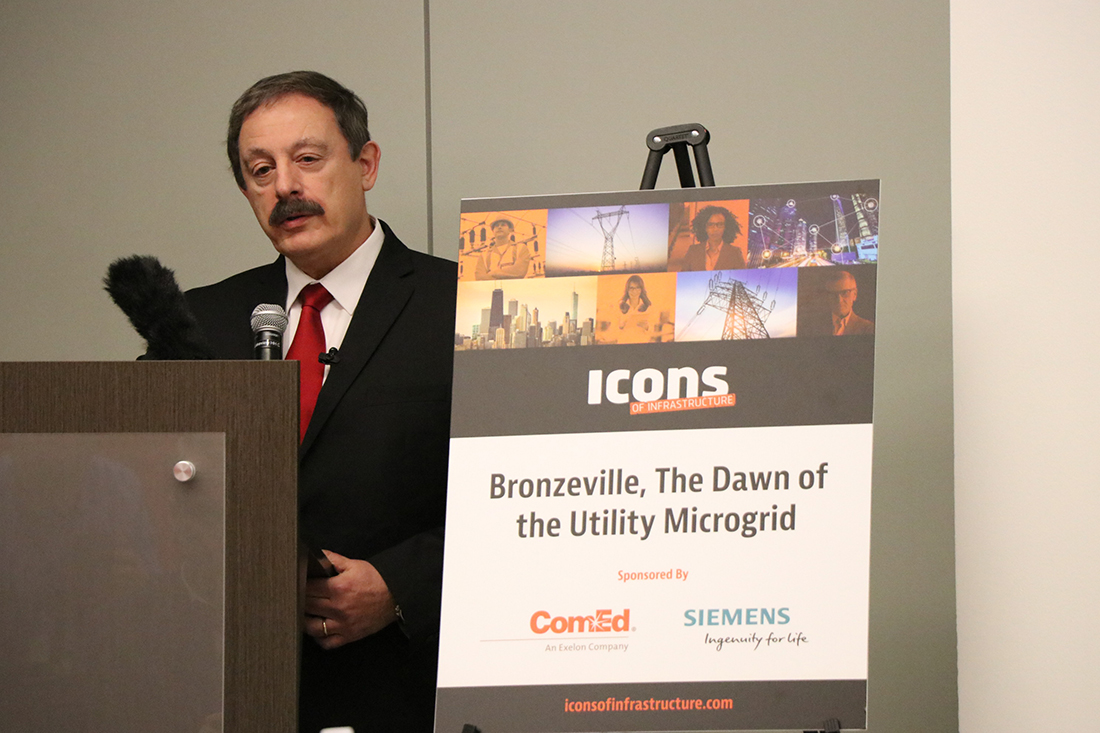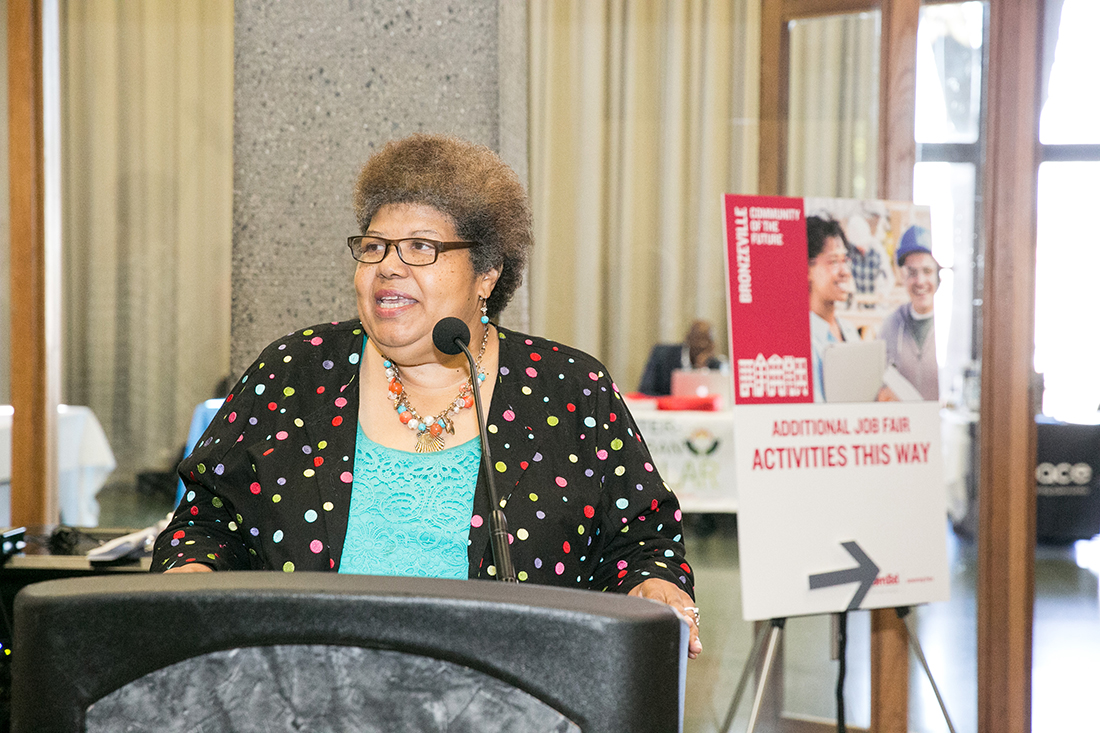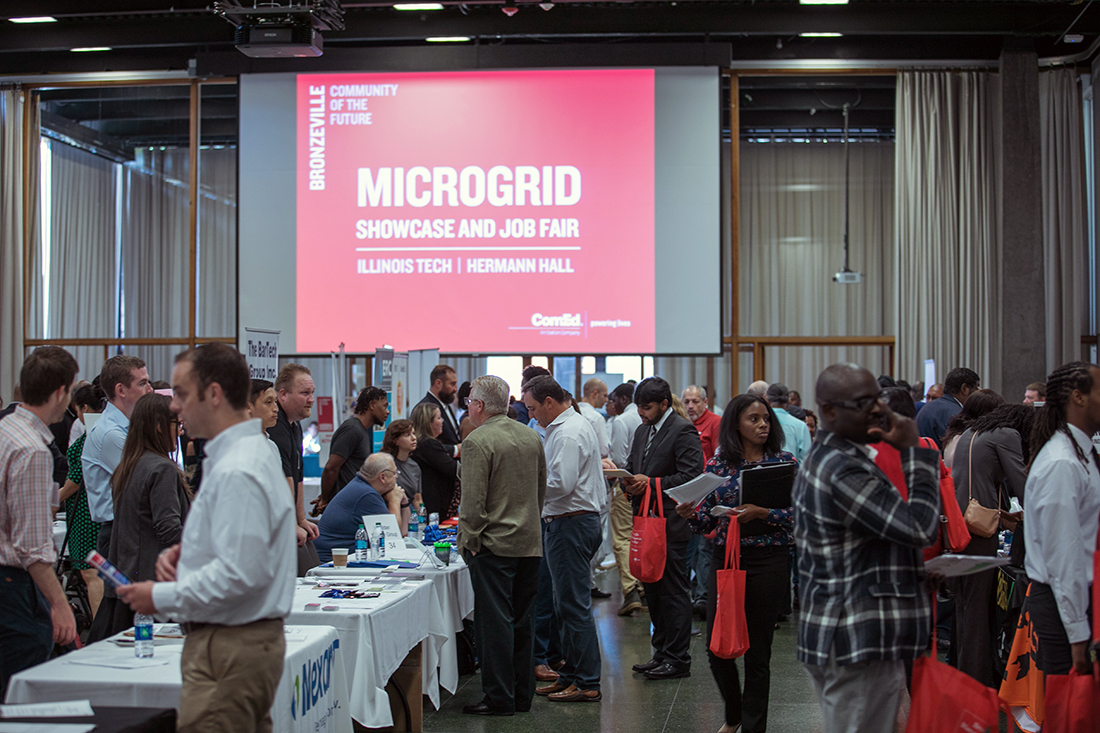By Jillian Melero
Medill Reports
Bronzeville, the South Side home of Chicago’s Black Renaissance and the birthplace of Black History Month, hopes to launch its next Golden Age with support from a smart microgrid being installed by utility ComEd. The microgrid will tap green energy to help power the community.
Once completed in 2019, the grid will have a load, or active consumption capacity of 7 megawatts, installed over two phases with the energy generated from its own resources including solar panels.
That’s enough generating capacity for the grid to serve approximately 1,060 residential, commercial, and industrial customers. Previous microgrids have served military bases or hospitals and the Illinois Institute of Technology operates on one as well. But the Bronzeville and IIT microgrid cluster will be the first of its kind to serve a community within a metropolitan area, giving the community a more resilient power grid to help withstand outages.
Representatives from ComEd, the Illinois Institute of Technology (IIT) and Siemens Digital Grid North America met Dec. 4, to discuss the microgrid coming to Bronzeville.
“We have a microgrid in place at the university that was started in 2008. We completed the project in 2013 and it has saved the university about a million dollars annually,” said Mohammad Shahidehpour, Director of the Robert W. Galvin Center for Electricity Initiative at IIT. “In case of an emergency, we will be able to island the campus. And run the entire university as an islanded operation. So, even if there is a major outage in the neighborhood, in the area, in the vicinity of the university, the university campus will remain in operation.”

A microgrid is a smaller power grid that can operate independently, drawing on its own power sources, in this case relying on solar power and solar batteries to serve customers within the area. It can still be connected to the larger electric grid where it can draw, or supply energy as needed. The Bronzeville project will connect with the existing microgrid at IIT. Some benefits of microgrids, especially newer smart grids such as the one planned for Bronzeville, include fewer and shorter power outages, improved monitoring of power usage and, in this case, the use of renewable resources and production of clean energy.
For the next 10 years, Bronzeville will serve as a testing ground. In addition to undergoing a cost-benefit analysis, the microgrid cluster will be evaluated on more than 55 different metrics, including resilience, according to ComEd President and CEO Terence Donnelly.

“How do you measure resilience? It’s more than reliability. It’s more about hardening. It’s more about surviving storms, cyber-attacks, things like that. But we’ve worked with our stakeholders and the [Illinois Commerce Commission] to develop a model of resiliency that we’re looking to measure in Bronzeville,” said ComEd President and CEO Terence Donnelly.
Three aspects of resilience that Donnelly said will be examined include energy system resilience, measuring energy performance and resilience to threats; community resilience, evaluating the impacts the project has on the community of Bronzeville; and critical infrastructure resilience, measuring the ability of systems such as transportation and communication to withstand and recover from disruptions.
A Stronger Grid
A storm in November with heavy snow and high winds caused power outages for more than 300,000 ComEd customers.
“We haven’t seen an event like that since 1998. And without investing in smart grid over the last five years, this could have been much higher, and we could have seen outages of 500-600,000,” Donnelly said.
Over the course of 2011, before ComEd began modernizing its power grid, a total of 14 storms caused 2.8 million power outages. The average time to restore power for each customer was 366 minutes. In 2017, it took an average of 116 minutes to restore power, Crain’s Chicago Business reported. That year, 14 storms shut down power to 901,000 customers.
Questions of Cost
ComEd did not confirm whether the new technology and enhanced energy supply will increase or decrease utility bills for its customers.
“While we haven’t broken out the microgrid’s cost for each of ComEd’s 4 million customers, we know that microgrids have some positive economic impacts, including reducing costs associated with power outages; supporting economic growth, especially in the digital sector; and enabling valuable services to the grid and consumers, such as demand response, real-time pricing, day-ahead pricing, voltage and capacity support,” ComEd Director of Communications Paul Elsberg wrote in an email.
Data from the Department of Energy (DOE) projects that the cost of energy will continue to increase but that future increases will be more gradual post smart grid installation.
The Bronzeville microgrid project received funding from two grants from the Department of Energy (DOE). The first grant for $1.2 million was awarded in September 2014 to develop and test the microgrid controller, the nerve center that will control the integrated microgrids of Bronzeville and the Illinois Institute of Technology (IIT). The second grant of approximately $4 million was awarded to study the integration of solar panels and batteries into the microgrid and requires a matching cost share of $4 million from ComEd and its university, laboratory, and technology partners, said ComEd Communications Director David O’Dowd.
In February, the Illinois Commerce Commission approved a $25 million investment in the microgrid project by Com Ed and its parnters. Along with the $4 million granted by the DOE, the total estimated cost for the microgrid as filed with the Illinois Commerce Commission (ICC) was $29 million.
The 2011 Electricity Infrastructure Modernization Act (EIMA) laid the groundwork for ComEd to implement annual rate increases to subsidize the estimated $2.6 billion for modernization of the power grid as a whole.
The utility raised its rates by 2.3 percent in June and was scheduled to issue another 8 percent increase in October. However, after a settlement negotiated by the ICC reallocated the cost of transmitting power across high voltage lines, ComEd customers saw the price of energy decrease instead, Crain’s reported. The lower pricing is locked in through May 2019.
Bronzeville, Community of the Future
Bronzeville’s smart grid is one step in a series of smart city developments in the works for the South Side neighborhood. ComEd’s projects include a “Save and Share” app to track energy usage; an electric vehicle mobility program, the ComEd Dash, that serves a seniors’ home in the area; and an energy storage initiative installing batteries for power storage as well as electric vehicle (EV charging stations). The initiative will also include a partnership with Aris Renewable Energy to install street lights outfitted with solar panels and wind turbines and “smart kiosks,” interactive digital displays in high-traffic areas that provide emergency alerts, maps and directions, news and other public information.
“We have a robust partnership with the Bronzeville community advisory council that’s extremely active,” Donnelly said. “We have many initiatives there, for example, outreach around stem education, an energy academy, an Ideathon. Working with students over four years to expose them to these technologies to learn how to benefit the community.”
In order to build, maintain, and develop new innovations for Bronzeville’s “Community of the Future,” ComEd and the Bronzeville Community Development Partnership, a neighborhood advisory group, are developing education initiatives focused on STEM and STEAM (Science, Technology, Engineering, Arts, and Math) programs in area high schools.
Twelve Bronzeville high schools participated in the partnerships first “Ideathon” in December of last year. High school students attending school in Bronzeville were partnered with college mentors and engineers from ComEd as well as Silver Springs Network, a provider of smart grid products, headquartered in San Jose, California; Accenture, a Dublin-based management and consulting company that works in digital technology; AECOM, a Los Angeles-based engineering firm with multinational projects; and others to innovate new products. The 12 high schools were invited to participate after feedback from Bronzeville’s Community Development Partnership.
“Initially ComEd said, ‘Well, we’ve got X number of science and math schools that might be interested in this type of Ideathon,’ but the community was like, ‘No, we want all the schools to be involved,’” said Paula Robinson, President of the Bronzeville Community Development Partnership. “There were 12 high schools, so all of the high schools were involved.”
Robinson said it is the community partnership’s place to push for a seat at the table, the same as any other stakeholder such as ComEd parent company Exelon, or technology partners Siemens and Lockheed Martin.

“There’s kind of a collaborative self-interest that’s going on here, and that’s a lot to navigate,” said Paula Robinson, president of the Bronzeville Community Development Partnership. “That’s probably where ComEd gets a lot of engagement as well as grief from my organization because we are in some new territory. We are looking at opportunities where the community, beyond advising, can also be what we call innovators. Where we’re co-creating and innovating in this new space as well.”
Teams that made it to the final round pitched ideas to a panel of judges in the “Spark Tank.” King College Prep juniors Ashton Mitchell and Breshaiya Kelly won with their idea for a microprocessor designed to help prevent accidents when emergency vehicles travel through busy intersections.
The top three teams from King College Prep High School, Young Women’s Leadership Charter School and the De La Salle Institute received prizes of $2,000, $1,000, and $500, respectively.

The partnership hopes to boost Bronzeville’s economy infusing it with new green energy and smart technology jobs within the community, maintaining the microgrid, wind turbines, solar panels as well as developing new technologies. O’Dowd said the utility estimates that a 10 MW microgrid would create 50 jobs.
In September, ComEd hosted a microgrid showcase and job fair at the IIT campus to raise awareness about the microgrid project, how it might benefit the community, and to inform the community about job opportunities in the energy field and related industries. More than 50 employers participated and more than 200 people attended.

The microgrid area will run from 33rd Street to the north, 38th Street to the south, State Street to the West, and South Dr. Martin L. King Jr. Drive to the East. It will serve the Chicago Public Safety Headquarters, the De La Salle Institute, the Math & Science Academy, a library, a public works building, restaurants, health clinics, public transportation, educational centers and churches.
[googlemaps https://www.google.com/maps/d/u/1/embed?mid=1Hne2eD43LY4rbAhtk7SXyWc9G48B5Wzn&z=14&w=640&h=480]
In blue, the footprint of the Illinois Institute of Technology microgrid, completed in 2013. In red, the footprint of the Bronzeville microgrid, estimated for completion in 2019. The smart grid cluster will be the first of its kind, connecting a university, an urban community, and integrating solar power and battery storage.


